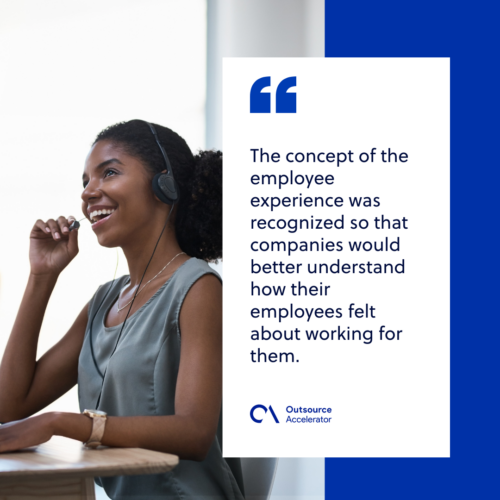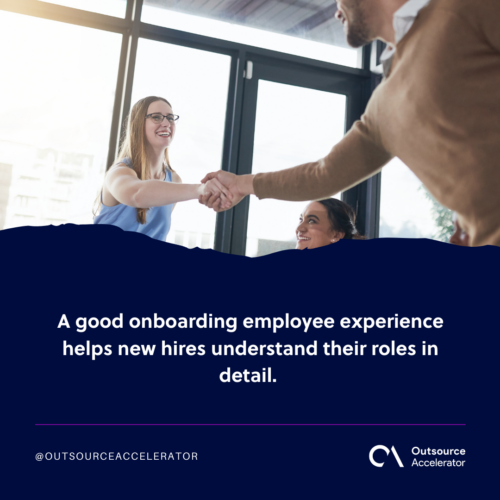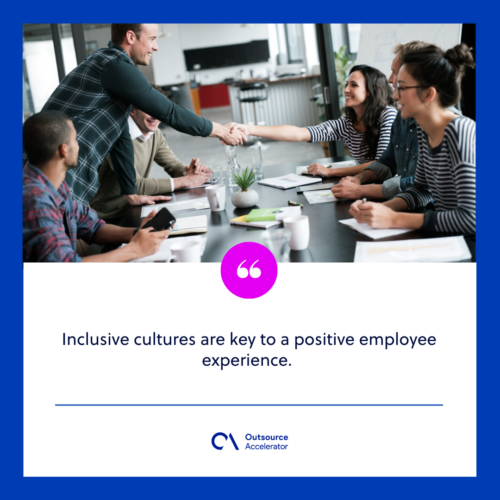The essentials of employee experience

If you ask someone what they’re looking for in a job, some common answers would be the pay or the career opportunities. Employee experience wouldn’t always be high on people’s lists.
However, the last few years have led to people reconsidering what their jobs mean to them. People are now seeking more meaningful work,[1] and companies, in response, have taken to improving the employee experience their organizations offer.
What is employee experience?
Employee experience is the sum of all the interactions an employee has with a company, from when they join to when they leave.
The concept of the employee experience was recognized so that companies would better understand how their employees felt about working for them. A positive employee experience is ideal, as happy workers[2] are more productive, loyal, and less likely to quit.
Some factors contributing to the employee experience are:
- Culture – how people are treated in the workplace and their attitude towards colleagues and superiors.
- Management – how well those in leadership roles communicate with and guide employees.
- Engagement – whether employees feel invested in the business’s success and how they see themselves contributing to its goals.
- Satisfaction – concerns the aspects employees like about working in a certain company.

What makes a positive employee experience?
Meeting employee needs and boosting engagement, output, and job satisfaction are key components of a healthy employee experience.
Here’s what constitutes a positive employee experience:
- A supportive and inclusive work environment
- Everyone is treated with respect and dignity
- Employees are engaged in the business strategy and encouraged to share ideas
- Communication channels are open, honest, and frequent
- Work is challenging yet meaningful
- There is a clear understanding of employee expectations
- Regular opportunities for feedback and recognition
BPO companies are experts in optimizing employee experience. For instance, Remote Employee thrives in giving the best employee experience possible through training programs and recognition for teams.
Key stages of the employee experience
In this section, we’ll go through the stages of the basic employee journey, from when they first started at the company to when they leave.
Companies should examine each stage for opportunities to enhance employee experience.
Attraction and acquisition
The beginning of employees’ relationship with a brand is when they first become aware of it. This can happen in several ways, such as through advertising, word-of-mouth recommendations, or just by happening upon the product.
When a person becomes interested in joining an organization, their first interaction will often be through the website. From the very start, a business needs to get its recruitment strategy right to attract top talent.
A good employee experience on the website (or other application methods) can make all the difference between receiving a candidate’s application form or losing them altogether.
Onboarding
Once new people join a company, leaders must ensure that they are clear about what is expected of them and how they can progress within the organization.
A good onboarding employee experience helps new hires understand their roles in detail.
The onboarding employee experience also helps them acclimate to the corporate culture so they can become productive as soon as possible.

Development
The development stage of the employee experience focuses on helping employees grow professionally through training opportunities and new responsibilities.
A comprehensive development program goes a long way to assuring employees that their employee experience is one where they can thrive and be successful.
Employees are more likely to remain engaged throughout their careers when properly developed. Managers play a critical role in this stage by providing feedback, coaching, and mentoring.
Exit
The final stage of the employee experience usually receives the least attention, but it’s no less important.
A departing employee leaves behind work, colleagues, clients, and any unfinished business. The exit should happen smoothly so as not to cause problems for either the employee or the employer.
In this stage, companies should note why the employee is leaving and what could be done to prevent it. The exit interview can provide valuable insights into workplace culture.
Tips for a robust employee experience strategy
Here are some tips to help you design a positive employee experience:
Map the employee journey
Companies should first map out the employee journey to start designing a positive employee experience strategy.
Management should think about each step in each phase of the journey. They must consider how each piece fits into the larger puzzle of creating a better employee experience for everyone involved.
Deliver excellent communication
An essential part of any employee experience is consistent communication.
This can be as simple as sending emails regularly or providing in-depth updates through the employee portal. Many organizations choose to send out information around specific holidays or events to make sure people are aware of their rights and responsibilities.
By providing regular updates about what’s happening in the company, management helps employees feel more involved and connected.
Focus on personalization
The best companies understand the differences between employee experiences.
Because people have different needs, interests, and expectations, an employee experience strategy should reflect this by offering personalized experiences for each employee.
Personalization helps employees feel valued and connected because they are treated as actual people.
Promote diversity and inclusion
The more diverse a workforce, the more diverse its ideas will be.
Inclusive cultures are key to a positive employee experience. They’re built on mutual respect and understanding and founded on open communication and transparency.
A diverse and inclusive employee experience also means ensuring everyone has growth opportunities, regardless of gender, religion, or ethnicity.

Make management supportive
Managers must understand that investing in employee experience is critical for a company’s success. If it feels like managers have no stake in the game, they won’t support efforts to improve the employee experience.
Everything starts with the right leadership. The initiative must come from above because employees have limited power to make changes themselves.
Employees are also more likely to stay with a company if management treats them well.
Use the right tools
Executing your employee experience strategy is easier with the right tools.
Tools like employee satisfaction surveys, mobile apps, and communication platforms can help you learn how employees feel about their work. These tools can be used for ongoing feedback loops and continuous improvement.
Make employee experience part of your company culture
To make employees feel valued, leaders should start by making them understand what it means to be part of the team. Employees should feel appreciated and encouraged to participate.
Companies that want to keep employees happy need to make employee experience part of the corporate culture. This means that the employees are at the heart of everything they do.







 Independent
Independent




